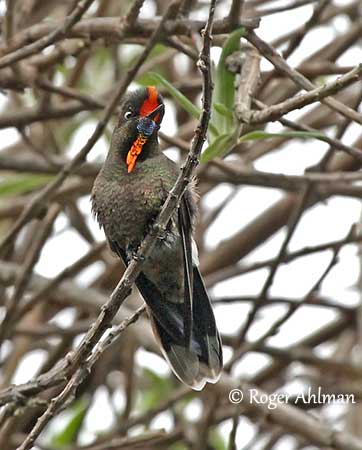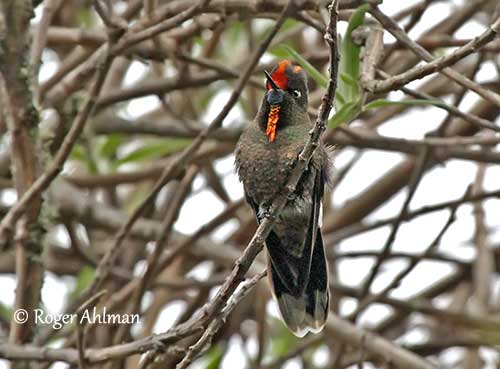
Fr: Métallure arc-en-ciel
Ang: Rainbow-bearded Thornbill
All: Weißspitzen-Glanzschwänzchen
Esp: Colibrí de Herrán
Ita: Spinibecco iridato
Nd: Regenboogdoornsnavel
Sd: Regnbågsnålnäbb
Photographer:
Roger Ahlman
Pbase Galleries Peru and Ecuador
Text by Nicole Bouglouan
Sources:
HANDBOOK OF THE BIRDS OF THE WORLD Vol 5 by Josep del Hoyo-Andrew Elliott-Jordi Sargatal - Lynx Edicions - ISBN: 8487334253
A GUIDE TO THE BIRDS OF COLOMBIA by Steven L. Hilty and William L. Brown - Princeton University Press – ISBN 069108372X
Arthur Grosset's Birds (Arthur Grosset)
Neotropical Birds – Cornell Lab of Ornithology
THE AVIANWEB - Beauty of Birds (Sibylle Faye)
Rainbow-bearded Thornbill
Chalcostigma herrani
Apodiformes Order – Trochilidae Family
INTRODUCTION:
The Rainbow-bearded Thornbill is part of the large “Andean clade” based on several features such as behaviour, displays, calls and songs, nesting habits and plumage characteristics.
This species occurs from C Andes of Colombia to W Andes, and both slopes in Ecuador and N Peru. It can be seen at high elevation, up to 2700/3600 metres and locally higher.
The Rainbow-bearded Thornbill shows several adaptations for living at high altitudes in extreme environment.
It is uncommon throughout its range and the population is declining.

DESCRIPTION OF THE BIRD:
Biometrics:
Length: 10-12 cm
Weight: L: 6,4 g – F: 5,5 g
The Rainbow-bearded Thornbill male has dark bronzy green upperparts and underparts, but rump and uppertail-coverts are reddish copper whereas vent and undertail-coverts are pale buff. The long, rounded tail is purplish to blue-violet, with outer rectrices broadly tipped white. The flight feathers are dark purplish.
There is a shaggy, beardlike, emerald green throat patch, extending down in glittering orange elongation and tapering to a fiery red point on the breast.
On the head, the crown is very dark, almost black, with median rufous stripe bordered black and slightly crested. The forehead is mostly rufous.
The short (13 mm), straight bill is black and flattened. The eyes are dark brown, with white post-ocular eye patch. Legs and feet are blackish, with white feathers on thighs.
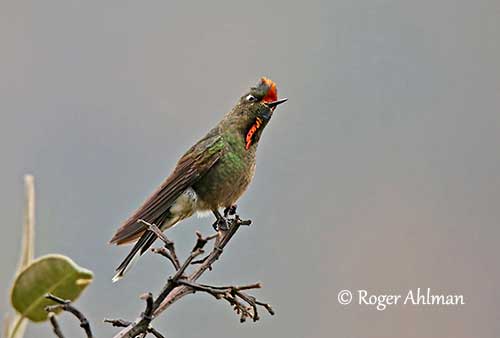
The female resembles male but she lacks the coloured beard. She has buffy brown underparts with dark green disked pattern on throat, breast and sides. She has the white post-ocular eye patch too.
The juvenile resembles female.
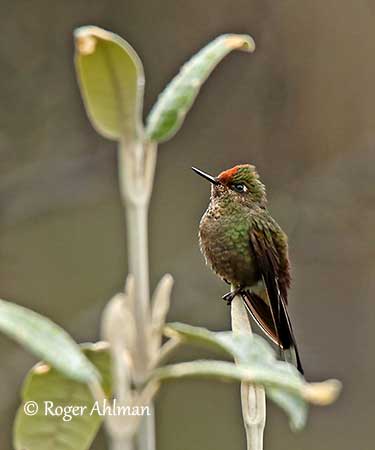

SUBSPECIES AND RANGE:
The Rainbow-bearded Thornbill has two subspecies.
C.h. tolimae is found in Volcán Tolima in C Andes of Colombia. This race is darker green.
C.h. herrani occurs in W Andes of S Colombia, S on both slopes in Ecuador and N Peru (to Piura and NW Cajamarca).
HABITAT:
The Rainbow-bearded Thornbill frequents the edges of high montane forests and scrubs, shrubby edges and grasslands throughout the range, and patches of brush in páramo.
It is visible around 4000 metres of elevation on Volcán Tolima, but usually mostly between 2700 and 3600 metres.
CALLS AND SONGS: SOUNDS BY XENO-CANTO
The Rainbow-bearded Thornbill utters a short tinkle followed by several squeaky notes, usually more melodious “tititrtrtrrr-skeew-skeew-skeew” and variants.
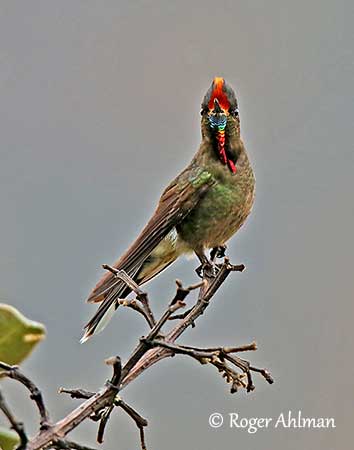
BEHAVIOUR IN THE WILD:
The Rainbow-bearded Thornbill feeds on nectar from flowers, and its short, flattened bill allows it to get the nectar from the numerous small flowers that are growing at high elevation. It also clings to the flower instead of hovering, in order to conserve energy.
But it also gleans insects while feeding on nectar. It takes them from the corollas, foliage and bark. It usually flicks the prey into the air before swallowing it.
These hummingbirds may feed on numerous small insects when the nectar becomes too scarce, showing beautiful adaptation to its high altitude habitat. It often feeds alone.
At the beginning of the breeding season, the male gives advertising songs and performs aerial displays. The iridescent parts of its plumage are enhanced while the male sings from dispersed singing posts. The female perches motionless near a singing male to draw its attention prior to copulation. The male is usually polygynous and mates with several females. Both sexes separate after the copulation.
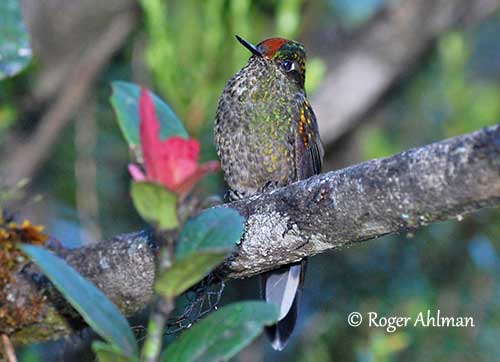
The Rainbow-bearded Thornbill is probably sedentary with seasonal altitudinal movements. It survives cold nights by entering a torpor involving slower breathing and heart rate, in order to save energy.
Like most Trochilidae, it hovers easily and it is highly manoeuvrable.
REPRODUCTION OF THIS SPECIES:
From an observation, nest-building is reported in mid-July. The female builds the nest in a small hole on cliff face. The nest has thick walls and is well-insulated. It is hidden behind some hanging vegetation or among ferns. It can be placed several metres above water.
The female lays 1-2 pinkish-white eggs and incubates alone. The high-Andean species usually incubate during 22-23 days, and the young fledge about 30-40 days after hatching. The female probably feeds them for several days after fledging.
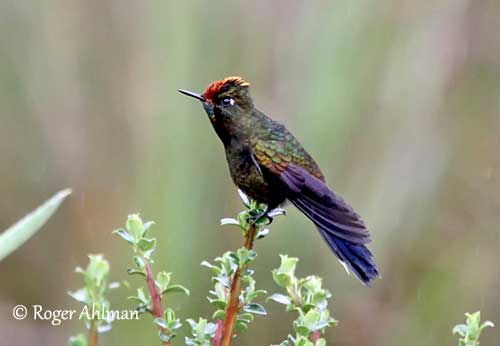
PROTECTION / THREATS / STATUS:
The Rainbow-bearded Thornbill is uncommon to locally common. It occurs in several National Parks throughout the Andean range.
The species is threatened by disturbance due to gold prospectors that are now pushing for access, involving increasing pressure.
The population has not been quantified, but it is suspected to be declining. But currently, the Rainbow-bearded Thornbill is evaluated as Least Concern.
